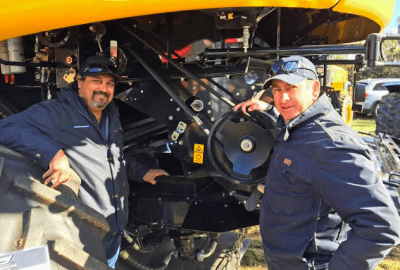THE Integrated Harrington Seed Destructor (iHSD) has been upgraded ahead of the 2018 harvest to bolster the harvester-integrated destructor’s ability to destroy nearly all weed seeds.

McIntosh Distribution’s Max Herbert and McIntosh & Son WA southern branches manager Devon Gilmour with an iHSD fitted to a New Holland CR10.90 combine harvester at the recent Newdegate Machinery Field Days.
The iHSD has recorded a kill rate of up to 99 per cent of targeted weed seeds, and McIntosh Distribution said new adjustments have been designed to enhance its durability.
Comprising of two hydraulically-driven cage mills retro-fitted to the rear of the harvester just below the sieves, the iHSD enables one-pass weed control.
This, in turn, reduces herbicide-resistant weed burdens, and allows for more targeted and efficient chemical control in following seasons and reduced burning, hence also improving soil organic matter.
Invented by Western Australian grower Ray Harrington, the iHSD was developed by UniSA with funding and support from the Grains Research and Development Corporation.
SKF Engineering and DeBruin Engineering were enlisted to help develop the major upgrades, which have included a wider mill, a cooler relocation to assist with oil cooling and a total redesign of the bearings and housing.
McIntosh Distribution agent, Johnny Inferrera, said the recent upgrades were the result of ongoing grower consultation by McIntosh Distribution to enhance the technology.
“We have been working closely with growers and any issues that have been identified are included in these latest upgrades, which are currently being rolled out to existing clients,” Mr Inferrera said.
“Even before these upgrades, we’ve maintained kill rates at up to 99pc, and growers using the iHSD have been happy with the kill rates they have been achieving.”
This year has also seen the iHSD being trialed in Europe, and Mr Inferrera said while comprehensive results were expected later this month, the feedback so far had been very positive.
“What we can say is that there has been 180 hours of harvesting done on European crops using the iHSD, with absolutely no issues.”
McIntosh Distribution has just completed the iHSD upgrades for Western Australian grower Campbell Jones, who farms with his father, Brian, on their 5000-hectare property north of Wyalkatchem.
The family runs a total cropping enterprise, leaving up to 400ha out of the cropping program each year for a chemical fallow.
This year’s program comprises of wheat, barley and canola, and it will be their third season using the iHSD.
Campbell Jones said they faced a typical wheatbelt broadacre weed burden, including ryegrass and radish, and had been increasingly mindful of herbicide resistance.
“Prior to getting the iHSD we were windrowing and burning, and we were finding that it just wasn’t an effective option for us,” Mr Jones said.
“Most years we weren’t getting a very good burn, so we looked at getting this system as another tool we could use to try and get on top of weeds.”
Campbell said he didn’t realise how much impact the iHSD was having until he saw a strip comparison on his property earlier this year, where the system had not been used and the weeds were clearly more prominent.
“It was pretty obvious where the iHSD had been on and where it hadn’t. One side was as clean as anything and the other was just dirty with weeds.
“We don’t expect an instant result with something like this. It’s something we’re using as a long-term tool to reduce the weed seed bank, so that was interesting to see.
Source: McIntosh Distribution

HAVE YOUR SAY